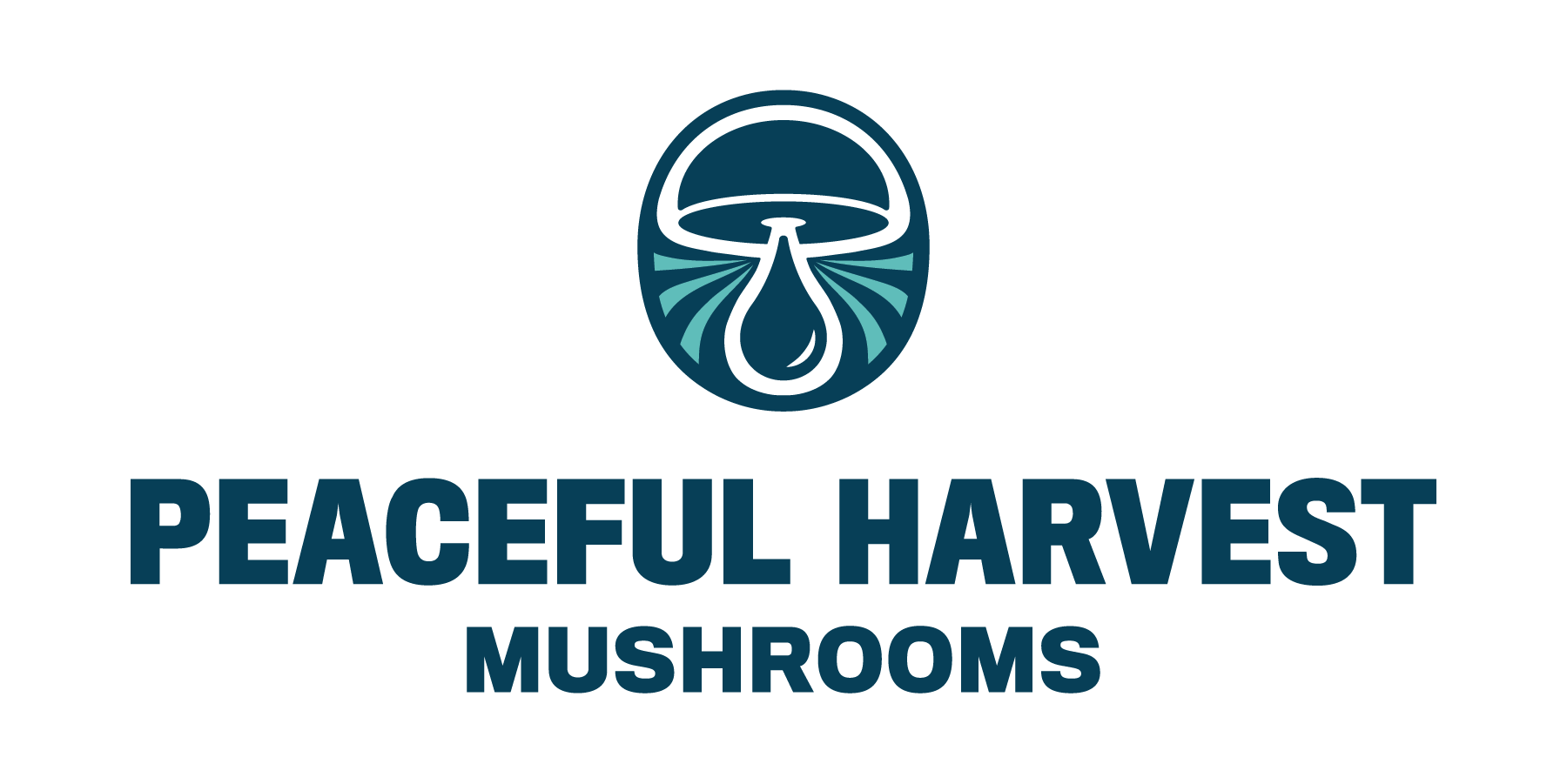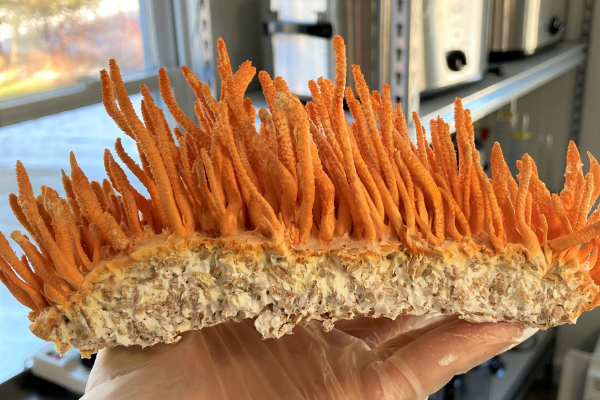There is so much conflicting information out there today about mushroom powders, so to help you make informed choices, we’re sharing what we know, and how we make our powders.
Jump to Our Powder Process Shop Our Powders
Clearing up some misinformation
The latest marketing hype challenges the efficacy of mycelium compared to the fruiting body, and duplicitously labels myceliated grain as a filler. To shed some light on what’s really going on, let’s start with the mycelium.
Medicinal value of mycelium and fruiting bodies
Myceliated grain
Mycelium live and multiply by digesting, in our case, organic grain. To live, mycelium secrete enzymes to break down their food (the grain), and then absorb it through their cell walls. This process transforms the grain into a new, fermented substance, called myceliated grain. The mycelium and myceliated grain become inseparable, and beneficial, in their own unique way, which is why digested grain is included in the powder ingredients of powders that include mycelium.
Quality matters
The efficacy of a product is about much more than the fruiting body or the mycelium. They both work. Quality is just as important, and a quality product depends upon certain environmental and procedural conditions. For example, was the mycelium allowed to fully colonize? The longer you let the mycelium colonize, the more grain is digested, creating a more robust product. How fresh is your product? Just like all fresh whole food, the closer to harvest, the more viable the nutritional and medicinal value. How long did it take after the mushrooms were harvested to get them dried, shipped to the processing company, the processing company turning them into powdered extracts, then shipped overseas to the next formulation manufacturer to be made into the final product that you see? Who knows. Remember, anything in its powdered form will degrade most rapidly. How clean was the air and water used to grow the mushrooms? We are what we eat, and mushrooms are no different. Where are the mushrooms grown and processed? Most companies buy their “mushrooms” from overseas as powdered extracts and many have their products contract manufactured and it’s nearly impossible to tell by looking at the label, which leaves many unanswered questions about quality. Just having a testing label doesn’t guarantee the quality. This is why it’s so important to know your farmer.
Powder processing
Whole mushroom vs powdered extract or resin
Some companies, like us, powder the whole mushroom while others create a powdered extract or “resin”. There are pros and cons to both. Like all foods, the further you process away from the original food, the more you lose its nutritional benefits. Mushroom extract powders are processed by making a hot water slurry or an alcohol first, and then hot water slurry, filtering off the mushrooms and then putting the liquid into a spray dryer, evaporating the water off, which leaves a powder substance, that is then dried. This is how overseas manufacturers create “mushroom powders”. Domestically, small growers use off-the-shelf small equipment like Extract Craft to evaporate off the alcohol. This is an extract powder (water only) or double extract powder (water and alcohol). While this preparation can be made quite concentrated and readily dissolves in beverages and other formulations, you lose most of the incredibly important nutritive components of the mushroom like the insoluble fiber. Insoluble fiber is incredibly important nutritionally to keep our digestive system functioning well and to feed our microbiota in the digestive system. Our microbiota create most of our serotonin and even some really important vitamins that our body can’t produce along with a whole bunch of other important functions! Also, none of the current clinical research is done on these highly concentrated products. Does more concentrated equal more biological effect? Maybe, maybe not; there is no supporting research, but typically there is a peak where more just can’t be utilized by our body. Processing and shipping of powdered extracts or concentrated resins, like this, allows for even more degradation of the medicinal value, and is also very energy and resource intensive.
Our Powder Process
We choose to honor what nature has shared with us and give a huge nod to the newest research on gut health by not super-processing and ultra-concentrating the mushroom out of our mushrooms. We activate the whole mushroom fruiting bodies along with fully colonized mycelium on digested grain with a short duration pressure steam to most effectively break down the polysaccharides into biologically active beta glucans while also preserving the other constituents as much as possible. We steam activate within 24-48 hours of fresh mushroom harvest, followed by dehydration. And, we only powder when we need product based on demand.
Our process has been reviewed and approved by a Food Safety Authority. We monitor our dehydrator temperatures and test for Water Activity per USDA food safety, and test regularly to ensure our process meets food safety standards as well as supplement GMPs. That is the benefit of growing and processing our own; we are in control of all the steps. We work in small batches, in our own FDA registered commercial kitchen, right on the farm. We continually educate ourselves and draw upon decades of experience in R & D and manufacturing pharmaceuticals, cultivating mushrooms, and clinical herbal medicine, in developing our processes while minimizing our impact on the ecosystem and formulating for the optimal health benefits. You get ALL the benefits from the mushrooms and you can’t get fresher than that! We believe THAT is QUALITY.
Lion’s Mane powder
Cordyceps power
Cordyceps fruits directly on it’s digested substrate unlike other mushroom species and as you can see below, the mycelium is prolific. Discarding this medicinal mycelium as waste in order to make the marketing claim that our product is fruiting body only, just feels wrong to us. Our Cordyceps Complete Activated Powder has tested at 10-40% beta glucans.
Cordyceps Fruiting Bodies and Myceliated Grain
Get to know your medicine maker
You should be able to ask your medicine maker about their processes, how fresh their mushrooms are and where their mushrooms are sourced. Most companies don’t make their own products. Some will cultivate and use a third party manufacturer and some companies don’t cultivate OR manufacture! They just create the formulation and packaging, more like a branding company. One way to tell if they make their own product is to check the label. FDA supplement regulations require it must be stated on the packaging “manufactured for” and also require 100% testing if it is an “ingredient” being used. This is why many companies can put their test results on their websites as the powders being shipped MUST have testing. It’s often nearly impossible from a website to know if the company cultivates their own mushrooms or makes their own products, but you should be able to ask the company, and a good quality company will be happy to give you the details..
Select References (definitely not all inclusive!):
Benson, Kathleen F., Paul Stamets, Renee Davis, Regan Nally, Alex Taylor, Sonya Slater, and Gitte S. Jensen. “The Mycelium of the Trametes Versicolor (Turkey Tail) Mushroom and Its Fermented Substrate Each Show Potent and Complementary Immune Activating Properties in Vitro.” BMC Complementary and Alternative Medicine 19, no. 1 (December 2019): 342. https://doi.org/10.1186/s12906-019-2681-7.
Friedman, “Chemistry, Nutrition, and Health-Promoting Properties of Hericium Erinaceus (Lion’s Mane) Mushroom Fruiting Bodies and Mycelia and Their Bioactive Compounds.”
Sugita, Peter, Mr Fadlan, Djanggan Sargowo, and A Rizal. “Abstract P2071: β-1,3/1,6-d-Glucan Of Indonesian Ganoderma Lucidum Mycelium Extract Reduces Systolic Blood Pressure & Inflammation In Hypertensive Patients.” Hypertension 74, no. Suppl_1 (September 2019): AP2071–AP2071. https://doi.org/10.1161/hyp.74.suppl_1.P2071.
NEW Pallav, Kumar, Scot E. Dowd, Javier Villafuerte, Xiaotong Yang, Toufic Kabbani, Joshua Hansen, Melinda Dennis, Daniel A. Leffler, David S. Newburg, and Ciarán P. Kelly. “Effects of Polysaccharopeptide from Trametes Versicolor and Amoxicillin on the Gut Microbiome of Healthy Volunteers: A Randomized Clinical Trial.” Gut Microbes 5, no. 4 (July 1, 2014): 458–67. https://doi.org/10.4161/gmic.29558.
Stamets, Paul. “Trametes Versicolor (Turkey Tail Mushrooms) and the Treatment of Breast Cancer.” Global Advances in Health and Medicine 1, no. 5 (November 2012): 20. https://doi.org/10.7453/gahmj.2012.1.5.007.
Vigna, Luisella, Federica Morelli, Gianna M. Agnelli, Filomena Napolitano, Daniela Ratto, Alessandra Occhinegro, Carmine Di Iorio, et al. “Hericium Erinaceus Improves Mood and Sleep Disorders in Patients Affected by Overweight or Obesity: Could Circulating Pro-BDNF and BDNF Be Potential Biomarkers?” Evidence-Based Complementary and Alternative Medicine : ECAM 2019 (April 18, 2019): 7861297. https://doi.org/10.1155/2019/7861297.
Benson, Kathleen F., Paul Stamets, Renee Davis, Regan Nally, Alex Taylor, Sonya Slater, and Gitte S. Jensen. “The Mycelium of the Trametes Versicolor (Turkey Tail) Mushroom and Its Fermented Substrate Each Show Potent and Complementary Immune Activating Properties in Vitro.” BMC Complementary and Alternative Medicine 19, no. 1 (December 2, 2019): 342. https://doi.org/10.1186/s12906-019-2681-7.
Davis, Renee, Alex Taylor, Regan Nally, Kathleen F Benson, Paul Stamets, and Gitte S Jensen. “Differential Immune Activating, Anti-Inflammatory, and Regenerative Properties of the Aqueous, Ethanol, and Solid Fractions of a Medicinal Mushroom Blend.” Journal of Inflammation Research Volume 13 (February 2020): 117–31. https://doi.org/10.2147/JIR.S229446.
Lin, Shin-Yi, Yu-Kai Chen, Hui-Tzu Yu, Gayane S. Barseghyan, Mikheil D. Asatiani, Solomon P. Wasser, and Jeng-Leun Mau. “Comparative Study of Contents of Several Bioactive Components in Fruiting Bodies and Mycelia of Culinary-Medicinal Mushrooms.” Begell House, 2013.
Fijałkowska, Agata, Bożena Muszyńska, Katarzyna Sułkowska-Ziaja, Katarzyna Kała, Anna Pawlik, Dawid Stefaniuk, Anna Matuszewska, et al. “Medicinal Potential of Mycelium and Fruiting Bodies of an Arboreal Mushroom Fomitopsis Officinalis in Therapy of Lifestyle Diseases.” Scientific Reports 10, no. 1 (November 18, 2020): 20081. https://doi.org/10.1038/s41598-020-76899-1.
Berger, Ralf G., Sven Bordewick, Nina-Katharina Krahe, and Franziska Ersoy. “Mycelium vs. Fruiting Bodies of Edible Fungi—A Comparison of Metabolites.” Microorganisms 10, no. 7 (July 8, 2022): 1379. https://doi.org/10.3390/microorganisms10071379.
Spelman, Kevin, Elizabeth Sutherland, and Aravind Bagade. “Neurological Activity of Lion’s Mane ( Hericium Erinaceus ).” Journal of Restorative Medicine 6 (December 1, 2017): 19–26. https://doi.org/10.14200/jrm.2017.6.0108.
Zhang, Mei. “Heating-Induced Conformational Change of a Novel β-(1→3)-D-Glucan from Pleurotus Geestanus.” Biopolymers 93, no. 2 (February 2010): 121–31. https://doi.org/10.1002/bip.21303.
Ruiz-Herrera, José, and Lucila Ortiz-Castellanos. “Cell Wall Glucans of Fungi. A Review.” The Cell Surface 5 (December 1, 2019): 100022. https://doi.org/10.1016/j.tcsw.2019.100022.
Li, I.-Chen, Li-Ya Lee, Tsai-Teng Tzeng, Wan-Ping Chen, Yen-Po Chen, Young-Ju Shiao, and Chin-Chu Chen. “Neurohealth Properties of Hericium Erinaceus Mycelia Enriched with Erinacines.” Behavioural Neurology 2018 (May 21, 2018): e5802634. https://doi.org/10.1155/2018/5802634.
Li, I-Chen, Han-Hsin Chang, Chuan-Han Lin, Wan-Ping Chen, Tsung-Han Lu, Li-Ya Lee, Yu-Wen Chen, Yen-Po Chen, Chin-Chu Chen, and David Pei-Cheng Lin. “Prevention of Early Alzheimer’s Disease by Erinacine A-Enriched Hericium Erinaceus Mycelia Pilot Double-Blind Placebo-Controlled Study.” Frontiers in Aging Neuroscience 12 (2020). https://www.frontiersin.org/articles/10.3389/fnagi.2020.00155.


